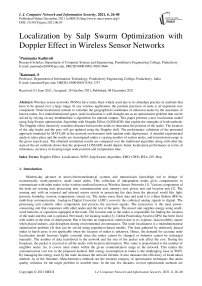Localization by Salp Swarm Optimization with Doppler Effect in Wireless Sensor Networks
Автор: Panimalar Kathiroli, Kanmani S.
Журнал: International Journal of Computer Network and Information Security @ijcnis
Статья в выпуске: 6 vol.13, 2021 года.
Бесплатный доступ
Wireless sensor networks (WSNs) have lately been widely used due to its abundant practice in methods that have to be spread over a large range. In any wireless application, the position precision of node is an important core component. Node localization intends to calculate the geographical coordinates of unknown nodes by the assistance of known nodes. In a multidimensional space, node localization is well-thought-out as an optimization problem that can be solved by relying on any metaheuristic’s algorithms for optimal outputs. This paper presents a new localization model using Salp Swarm optimization Algorithm with Doppler Effect (LOSSADE) that exploit the strengths of both methods. The Doppler effect iteratively considers distance between the nodes to determine the position of the nodes. The location of the salp leader and the prey will get updated using the Doppler shift. The performance validation of the presented approach simulated by MATLAB in the network environment with random node deployment. A detailed experimental analysis takes place and the results are investigated under a varying number of anchor nodes, and transmission range in the given search area. The obtained simulation results are compared over the traditional algorithm along with other the state-of-the-art methods shows that the proposed LOSSADE model depicts better localization performance in terms of robustness, accuracy in locating target node position and computation time.
Doppler Effect, Localization, WSN, Salp Swarm Algorithm, EHO, GWO, BSA, DV-Hop
Короткий адрес: https://sciup.org/15018185
IDR: 15018185 | DOI: 10.5815/ijcnis.2021.06.03
Список литературы Localization by Salp Swarm Optimization with Doppler Effect in Wireless Sensor Networks
- Han, G., Xu, H., Duong, T.Q., Jiang, J., Hara T, “Localization algorithms of wireless sensor networks: A survey”, Springer journal of telecommunication systems, Volume 52, Issue 4, 2013, Pages 2419–2436
- D.Niculescu, B.Nath, “DV based positioning in ad-hoc networks,” Telecommunication Systems, Volume 22,Issue 1–4,Pages. 267–280, 2003.
- Ahmed k. Daraj, Alhamzah T. Mohammad, Mahmood F. Mosle, “Indoor Localization Enhancement Based on Time of Arrival Using Sectoring Method”, International Journal of Intelligent Systems and Applications (IJISA), Vol.12, No.3, Jun. 2020, PP.1-7
- M. B. Nirmala, A. S. Manjunatha, “Enhanced Voting based Secure Localization for Wireless Sensor Networks “, International Journal of Computer Network and Information Security (IJCNIS), Vol.7, No.12, Nov. 2015, PP.52-59
- Santar Pal Singh, S. C. Sharma,” Critical Analysis of Distributed Localization Algorithms for Wireless Sensor Networks“, International Journal of Wireless and Microwave Technologies(IJWMT), Vol.6, No.4, Jul. 2016, PP.72-83
- D.H.Wolpert, W.G.Macready ,“No-free- lunch theorems for optimization ”IEEE transactions on evolutionary computation, Volume 1, Issue 1, 1997, Pages 67–82
- Miloud Mihoubi, Abdellatif rahmoun, Pascal Lorenz, Noureddine Lasla, “An effective bat algorithm for node localization in distributed wireless sensor network,” Security and privacy, Volume 1, Issue 1, Pages 1–20, 2018.
- Strumberger, I.; Beko, M.; Tuba, M.; Minovic, M.; Bacanin, N. Elephant Herding Optimization Algorithm for Wireless Sensor Network Localization Problem,” In Technological Innovation for Resilient., Springer International, 2018; Pages 175–184.
- Wang, G.G.; Deb, S.; Gao, X.Z.; Dos Santos Coelho, L. A new metaheuristic optimization algorithm motivated by elephant herding behavior. International Journal of Bio-Inspiration Computing, 2017, 8, Pages 394–409.
- Sankalap Arora, Satvir Singh, “Node Localization in Wireless Sensor Networks Using Butterfly Optimization Algorithm”, springer journal of science and engineering, Volume 42, 2017, Pages 3325–3335
- Amrita Datta, Mou Dasgupta, “On accurate localization of nodes in underwater sensor networks: a Doppler shift and modified genetic algorithm-based localization technique,” springer journal of Evolutionary Intelligence, 2019.
- Kussat NH, Chadwell CD, Zimmerman R, “Absolute positioning of an autonomous underwater vehicle using GPS and acoustic measurements”, IEEE journal of Ocean Engineering, Volume 30, Issue 1, Pages153–164, 2005.
- Yan J, Zhang X, Luo X, Wang Y, Chen C, Guan X, “Asynchronous localization with mobility prediction for underwater acoustic sensor networks”, IEEE journal of Transactions on Vehicular Technology, volume 67, Issue 3, Pages 2543–2556, 2017.
- Han Y, Zhang J, Sun D, “Error control and adjustment method for underwater wireless sensor network localization”, Elsevier journal of Applied Acoustics, Volume 130, Pages 293–299, 2018.
- Nagireddy V, Parwekar P, Mishra TK, “Velocity adaptation based PSO for localization in wireless sensor networks”, springer journal of Evolutionary Intelligence, 2018
- Phoemphon, S., So-In, C., Leelathakul, N, “A hybrid localization model using node segmentation and improved particle swarm optimization with obstacle awareness for wireless sensor networks”, Springer journal of expert systems with applications, Volume 143, 2020.
- Huthaifa M. Kanoosh,Mazen M. Selim,Essam Halim Houssein, “Salp Swarm Algorithm for Node Localization in Wireless Sensor Networks”, ACM Journal of Computer Networks and Communications, 2019.
- Zhou, G., He, T., Krishnamurthy, S., Stankovic, J, “Models and solutions for radio irregularity in wireless sensor networks”, ACM Transactions on Sensor Networks, Volume 2, Issue 2, Pages 221–262, 2006.
- S. Mirjalili, S. M. Mirjalili and A. Lewis, Grey wolf optimizer: Theory, Literature Review, and Application in Computational Fluid Dynamics Problems, Advances in Engineering Software, Volume 69, Pages 46-61, 2014.


